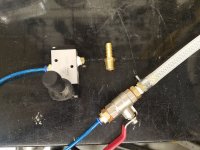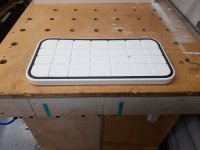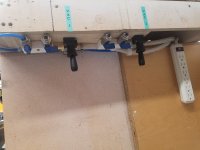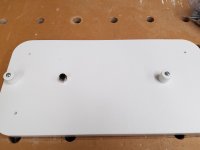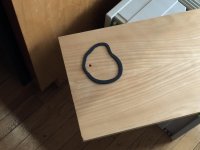Based on another thread I thought I would start a specific vacuum tubing thread. I am trying to get my system dialed in and the tubing/fittings leaking is my biggest issue. The clamps still work but the constant pump cycling is annoying me.
I did some testing this morning and figured I would post some results of the different configurations. Most of my system is comprised of 3/8id reinforced tubing and barb type fitting that terminate to 3/8 ball valves so I can hook different things as needed in different locations such as vacuum bags and clamps. I know these are leak free since my pump is always on and never cycles. So up to the ball valves its good. However I was having issues with the push to connect fittings which I had on the pods and the pneumatic valve after the ball valve.
I did the tests using the same setup and having 2 connectors one on the output of the ball valve and one on the input of the pneumatic valve.
6mm test = 6mm fittings with 6mm tubing leaked the worst. I could audibly hear the leak and it would get worse if I moved the valve or tubing around. I averaged about a 90 seconds before my pump would cycle.
1/4" tubing/6mm fittings = Since the 1/4" tubing is slightly over 6mm I tried that. The tubing goes in and is much more snug going in and out but still doable. However long term Im not sure if it will effect the internal o-ring and develop leaks later. This gave me a pump cycle time of 9.5 minutes
barb fittings = I did a control test using the barb fittings too. I stopped the test/timer at 32 minutes.
4mm = This is where things got a little interesting. The 4mm tubing with 4mm fittings performed as good as the barb fittings above. I stopped the test/timer at 32 minutes with no pump cycle. Not sure on longevity yet but I would love if it lasts. The 4mm tubing is nice its small, flexible and easy to work with and since the vacuum clamps dont need a large volume of air flow it still works well for vacuum clamping. vacuum bagging not so much. Im not sure if since the 4mm tubing is smaller more flexible it doesnt put as much strain on the internal o-ring.
Just figured I would post these results if anyone was thinking of doing their own and I already have a bunch of the tubing and fittings in all different sizes and since the vac sys is going away more may be looking to do their own.
Oh and the festool quick connects are ruled out on price alone. They want 60 bucks for just the coupler... I dint even price the other half after seeing that.
I did some testing this morning and figured I would post some results of the different configurations. Most of my system is comprised of 3/8id reinforced tubing and barb type fitting that terminate to 3/8 ball valves so I can hook different things as needed in different locations such as vacuum bags and clamps. I know these are leak free since my pump is always on and never cycles. So up to the ball valves its good. However I was having issues with the push to connect fittings which I had on the pods and the pneumatic valve after the ball valve.
I did the tests using the same setup and having 2 connectors one on the output of the ball valve and one on the input of the pneumatic valve.
6mm test = 6mm fittings with 6mm tubing leaked the worst. I could audibly hear the leak and it would get worse if I moved the valve or tubing around. I averaged about a 90 seconds before my pump would cycle.
1/4" tubing/6mm fittings = Since the 1/4" tubing is slightly over 6mm I tried that. The tubing goes in and is much more snug going in and out but still doable. However long term Im not sure if it will effect the internal o-ring and develop leaks later. This gave me a pump cycle time of 9.5 minutes
barb fittings = I did a control test using the barb fittings too. I stopped the test/timer at 32 minutes.
4mm = This is where things got a little interesting. The 4mm tubing with 4mm fittings performed as good as the barb fittings above. I stopped the test/timer at 32 minutes with no pump cycle. Not sure on longevity yet but I would love if it lasts. The 4mm tubing is nice its small, flexible and easy to work with and since the vacuum clamps dont need a large volume of air flow it still works well for vacuum clamping. vacuum bagging not so much. Im not sure if since the 4mm tubing is smaller more flexible it doesnt put as much strain on the internal o-ring.
Just figured I would post these results if anyone was thinking of doing their own and I already have a bunch of the tubing and fittings in all different sizes and since the vac sys is going away more may be looking to do their own.
Oh and the festool quick connects are ruled out on price alone. They want 60 bucks for just the coupler... I dint even price the other half after seeing that.

